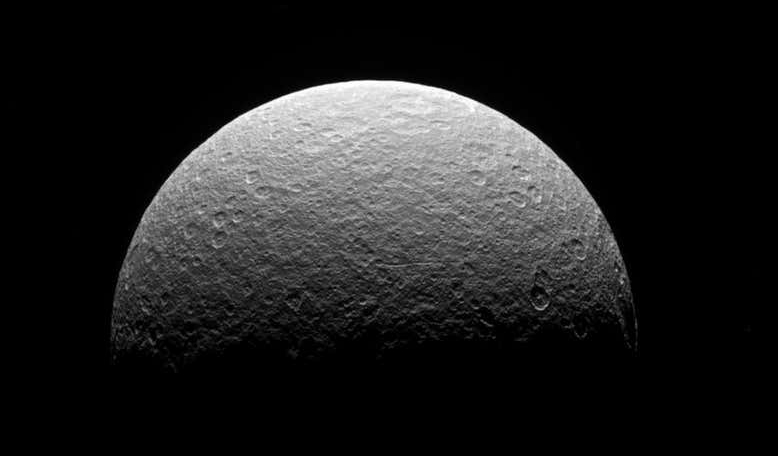An unexplained molecular feature found years ago on Saturn’s moon Rhea, might now be solved say an international team of researchers working on the puzzle. The compound, that was discovered by NASA’s Cassini spacecraft before it ended its mission by plunging into the ringed planet, could be hydrazine; a chemical often used as rocket fuel.
The Cassini mission to Saturn was one of NASA’s most ambitious efforts in planetary space exploration ever mounted.
Using a host of instruments, Cassini transformed our view of Titan, hinted that Enceladus was hiding an ocean and gave insights into Saturn’s iconic rings - just a few of the many discoveries this sophisticated robotic probe made during its 13 year tour of the Saturnian system.
While Cassini helped solve some planetary riddles, it also helped create some. Using its Ultraviolet Imaging Spectrograph (UVIS) – an instrument that separates incoming light by its wavelength or frequency – Cassini was tasked with determining the chemical compounds that made up the Saturn moon’s surfaces.
However a later study of this data revealed something intriguing; a portion of the light in the ultraviolet band of the electromagnetic spectrum, was being absorbed by a mysterious molecule.
This absorption feature, that centred around 184 nanometers, was spotted on several of Saturn’s moons, including Rhea.
Earlier studies indicated that the chemical signature could belong to water ice, but after using laboratory measurements to find a fit to the molecule, a team, headed by Mark Elowitz at the Open University, UK, now say that the likely candidate is hydrazine monohydrate.
Several chlorine-containing molecules could also be contenders say the team, but making chlorine naturally on the surface of an icy satellite is difficult. Further more, their origin on Rhea would require the presence of an internal ocean layer or exogenic delivery by micro-meteoroids and/or asteroids that contain chlorine.
Chlorine-based salts have been detected in plumes of Enceladus, another of Saturn’s icy moons, a finding which led to the suggestion that the 500 kilometre-wide moon had an internal ocean.
But, say Elowitz and colleagues, it is not likely that chlorine compounds could migrate to the surface of Rhea through cracks in the ice shell if an ocean existed below its frozen exterior.
Instead, hydrazine monohydrate is favoured as the mysterious compound due to the radiation-dominated chemistry expected to occur on the surface of Rhea.
Interestingly, hydrazine – which has the chemical formula N2H4 – was also used as a propellant in Cassini’s thrusters, but say Elowitz and colleagues, the thrusters were not used during icy satellite flybys “and thus the signal is believed to not arise from spacecraft fuel.”
Hydrazine could also be drifting over from Titan, another of Saturn’s moons. Larger than the planet Mercury, this extraordinary world is the only known moon with a substantial atmosphere, that like Earth’s is dominated by nitrogen.
If nitrogen, or a mixture of nitrogen and hydrogen, is escaping from Titan’s thick atmosphere, “then it is possible that Rhea could accumulate it as it orbits Saturn,” write the authors in their research paper recently published in Science Advances.
The authors calculate that assuming nitrogen (N2) has existed in Titan’s atmosphere over the last four billion years, the large moon could have lost a substantial amount of the gas equivalent to the mass of a huge asteroid. Once on Rhea’s surface, the nitrogen is then used to synthesis hydrazine providing it is not destroyed first.
Without a definitive solution as to how hydrazine is being produced on Rhea and knowing it is also present on other Saturnian moons, the team suggest further analysis is required to understand potential chemical pathways and transfer routes before the mystery can be truly resolved.











